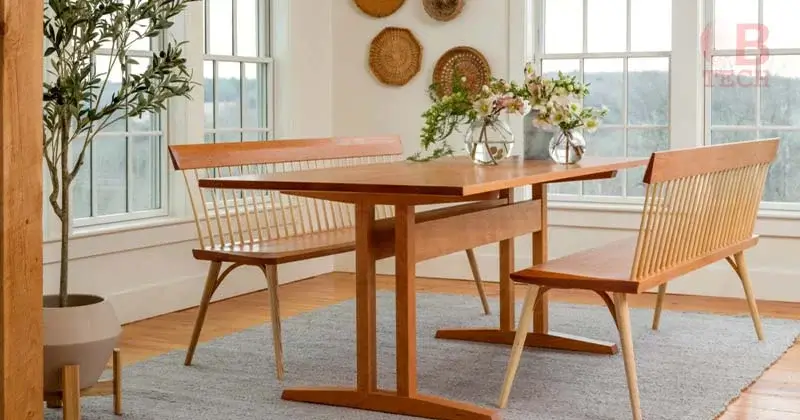Dining tables serve as the centerpiece of our homes, bringing family and friends together for shared meals and gatherings. Among the myriad of dining table styles available, the trestle table stands out for its timeless elegance and distinctive design.
This article delves into the characteristics that set trestle tables apart from other dining table styles, exploring their history, construction, and the aesthetic appeal they bring to diverse interior settings.
1. Historical Roots and Timeless Appeal
Trestle Tables have a rich historical legacy, dating back to medieval times. The design originated from the practical need for a table that could be easily disassembled and moved, making it ideal for communal spaces and gatherings. Despite its historical roots, the trestle table has endured the test of time and remains a popular choice, celebrated for its versatility and aesthetic charm.
2. Distinctive Base Structure
One of the key features that distinguish trestle tables from other styles is their unique base structure. Unlike pedestal tables that have a central support column or leg, trestle tables feature two parallel supports, known as trestles, connected by a horizontal beam. This open design allows for more flexibility in seating arrangements, making trestle tables an excellent choice for accommodating varying numbers of guests.
3. Versatile Seating Options
The trestle table’s design provides versatile seating options, allowing for more legroom and flexibility in chair placement. With no obstruction at the corners, trestle tables can comfortably accommodate a mix of dining chairs, benches, or even a combination of both. This versatility makes them suitable for various dining styles, from formal dinners to casual family gatherings.
4. Ease of Assembly and Disassembly
Echoing their historical origins, trestle tables are known for their practicality when it comes to assembly and disassembly. The absence of a central pedestal or complex leg structure simplifies the process, making it easier to transport the table or adjust its size to accommodate different seating needs. This feature adds to the functional appeal of trestle tables, especially in spaces where flexibility is key.
5. Aesthetic Elegance and Timeless Design
Trestle tables exude a timeless elegance that transcends design trends. The simple yet sophisticated silhouette of the trestle base, often with subtly curved or tapered legs, contributes to a classic and refined aesthetic. This enduring design quality allows trestle tables to seamlessly integrate into various interior styles, from traditional to contemporary.
6. Materials and Craftsmanship
Trestle tables showcase a range of materials and craftsmanship, offering options to suit different preferences and interior themes. Whether crafted from solid wood for a rustic, farmhouse charm or featuring sleek metal elements for a modern touch, the diverse material choices contribute to the versatility of trestle tables. The quality of craftsmanship further enhances their visual appeal and durability.
7. Space-Enhancing Design
The open and airy design of trestle tables has a space-enhancing effect, making them an excellent choice for smaller dining areas. The absence of bulky legs at the corners creates a more visually expansive look, giving the illusion of more space. This feature makes trestle tables a savvy choice for those looking to optimize the perceived size of their dining area.
8. Customization Opportunities
Trestle tables often offer customization opportunities, allowing buyers to tailor the table to their specific preferences. From selecting the type of wood or finish to choosing the size and shape of the tabletop, customization adds a personalized touch to trestle tables. This flexibility makes it easier for individuals to find a trestle table that aligns with their unique style and space requirements.
9. Complementary Bench Seating
The design of trestle tables lends itself well to bench seating, creating a cohesive and inviting dining setup. Benches can be easily tucked under the table, providing a streamlined look and allowing for a more casual and communal dining experience. This combination of trestle tables with benches is a popular choice for those seeking a relaxed and family-friendly atmosphere.
10. Adaptability to Different Interior Styles
While trestle tables have roots in medieval design, their adaptability to different interior styles is remarkable. Whether placed in a farmhouse kitchen, a contemporary dining room, or a rustic-chic setting, trestle tables seamlessly integrate into diverse design aesthetics. This versatility makes them a sought-after choice for homeowners and designers alike.
11. Distinct from Pedestal and Leg Tables
Compared to pedestal tables with a single central support and leg tables with multiple legs, trestle tables stand out for their distinct base structure. Pedestal tables often have a more formal and symmetrical look, while leg tables can vary in leg placement and design. Trestle tables, with their parallel supports and open design, offer a unique alternative that combines elegance with practicality.
12. Showcasing Handcrafted Details
Many trestle tables showcase handcrafted details that add to their appeal. Whether it’s intricate joinery, hand-carved accents, or artisan finishes, these details highlight the craftsmanship involved in creating trestle tables. Handcrafted elements contribute to the individuality of each piece and elevate the overall aesthetic value.
The Enduring Charm of Trestle Tables in Contemporary Living
Trestle tables stand as a testament to timeless design, practicality, and aesthetic elegance. Their distinctive base structure, versatile seating options, and adaptability to
different interior styles make them a preferred choice for those seeking a dining table that goes beyond mere functionality.
Whether used for formal dinners or casual gatherings, trestle tables bring an enduring charm that resonates with the past while enriching the present, making them a beloved addition to homes across various design preferences.



